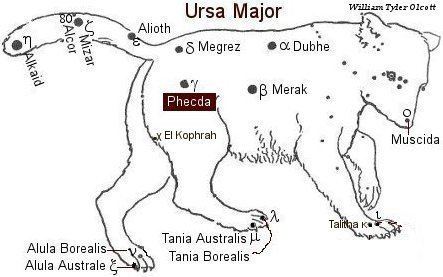Surface temperature 9,355 K Constellation Ursa Major | Magnitude 2.438 Apparent magnitude (V) 2.438 | |
 | ||
Radius 2.116 million km (3.04 R☉) Mass 5.211 × 10^30 kg (2.62 M☉) Similar Beta Ursae Majoris, Alpha Ursae Majoris, Delta Ursae Majoris, Epsilon Ursae Majoris, Eta Ursae Majoris | ||
Gamma ursae majoris
Gamma Ursae Majoris (γ Ursae Majoris, abbreviated Gamma UMa, γ UMa), also named Phecda, is a star in the constellation of Ursa Major. Since 1943, the spectrum of this star has served as one of the stable anchor points by which other stars are classified. Based upon parallax measurements with the Hipparcos astrometry satellite, it is located at distance of around 83.2 light-years (25.5 parsecs) from the Sun.
Contents
It is more familiar to most observers in the northern hemisphere as the lower-left star forming the bowl of the Big Dipper, together with Alpha Ursae Majoris (Dubhe, upper-right), Beta Ursae Majoris (Merak, lower-right) and Delta Ursae Majoris (Megrez, upper-left). Along with four other stars in this well-known asterism, Phecda forms a loose association of stars known as the Ursa Major moving group. Like the other stars in the group, it is a main sequence star not unlike the Sun, although somewhat hotter, brighter and larger.
Gamma Ursae Majoris is an Ae star, which is surrounded by an envelope of gas that is adding emission lines to the spectrum of the star; hence the 'e' suffix in the stellar classification of A0 Ve. It has 2.6 times the mass of the Sun, three times the Sun's radius, and an effective temperature of 9,355 K in its outer atmosphere. This star is rotating rapidly, with a projected rotational velocity of 178 km s−1. The estimated angular diameter of this star is about 0.92 mas. It has an estimated age of 300 million years.
Phecda is located in relatively close physical proximity to the prominent Mizar-Alcor star system. The two are separated by an estimated distance of 8.55 ly (2.62 pc); much closer than the two are from the Sun. The star Beta Ursae Majoris is separated from Gamma UMa by 11.0 ly (3.4 pc).
Nomenclature
γ Ursae Majoris (Latinised to Gamma Ursae Majoris) is the star's Bayer designation.
It bore the traditional names Phecda or Phad, derived from the Arabic phrase فخذ الدب fakhð ad-dubb 'thigh of the bear'. In 2016, the International Astronomical Union organized a Working Group on Star Names (WGSN) to catalog and standardize proper names for stars. The WGSN's first bulletin of July 2016 included a table of the first two batches of names approved by the WGSN; which included Phecda for this star.
To the Hindus this star was known as Pulastya, one of the Seven Rishis.
In Chinese, 北斗 (Běi Dǒu), meaning Northern Dipper, refers to an asterism consisting of Gamma Ursae Majoris, Alpha Ursae Majoris, Beta Ursae Majoris, Delta Ursae Majoris, Epsilon Ursae Majoris, Zeta Ursae Majoris and Eta Ursae Majoris. Consequently, Gamma Ursae Majoris itself is known as 北斗三 (Běi Dǒu sān, English: the Third Star of Northern Dipper) and 天璣 (Tiān Jī, English: Star of Celestial Shining Pearl).
